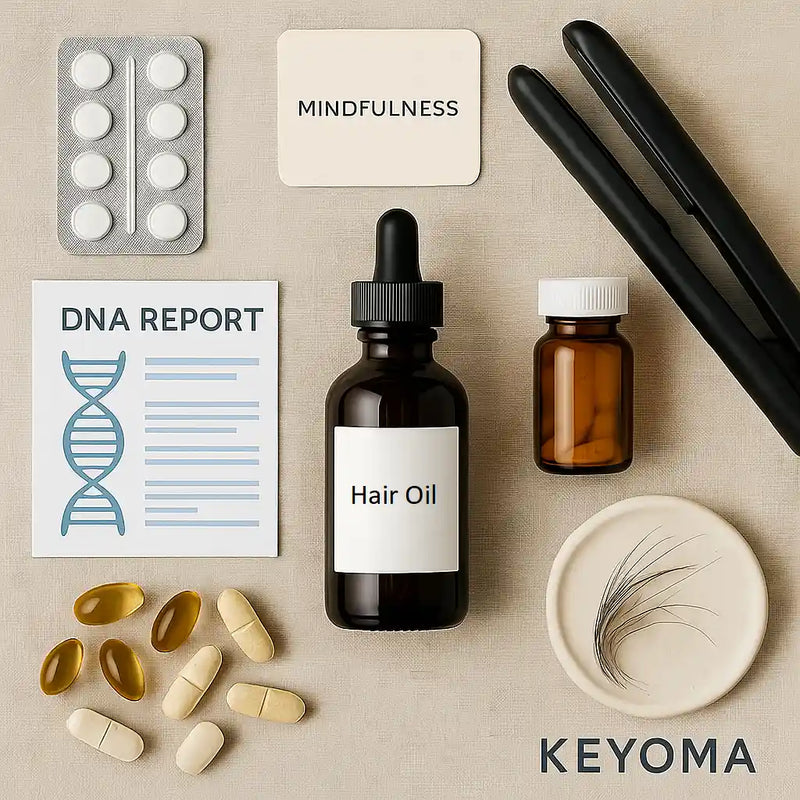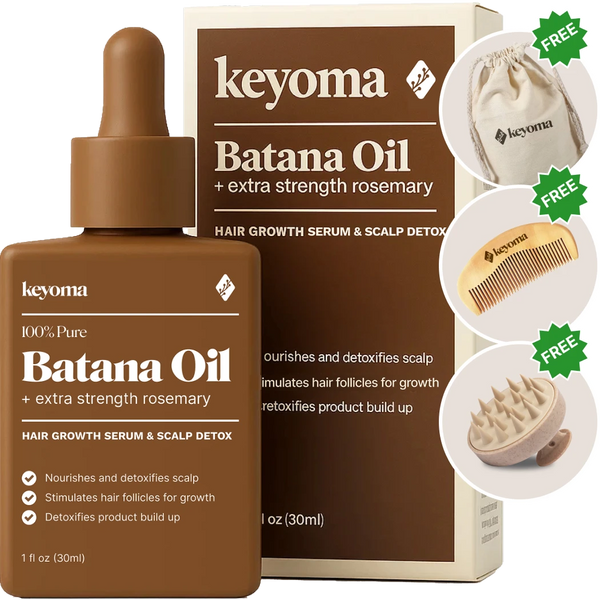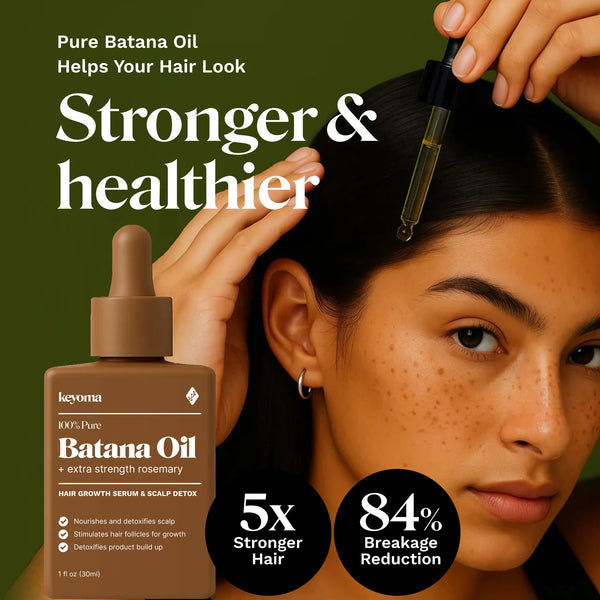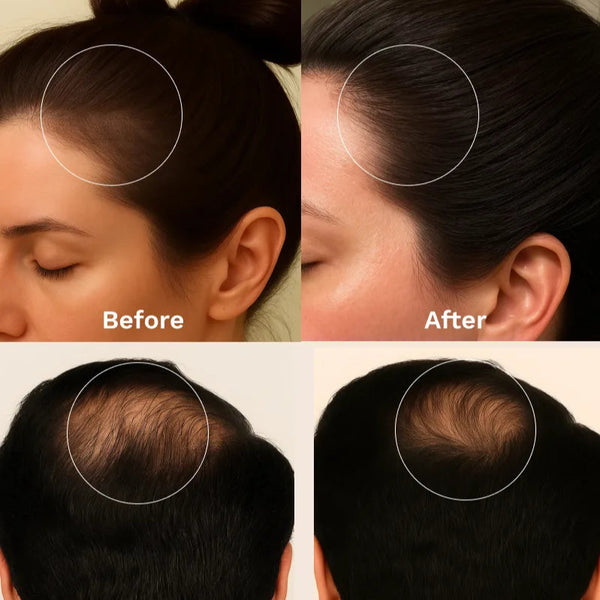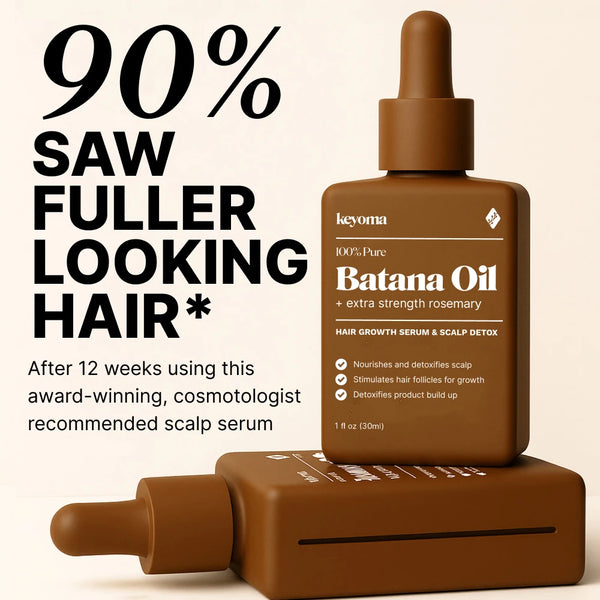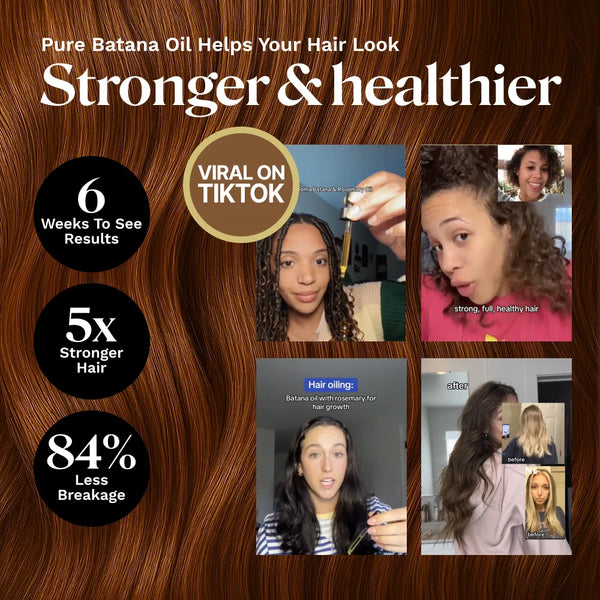In this article
Hair thinning rarely happens overnight. It creeps in slowly. Maybe your part looks wider, or you notice extra strands on your pillow. A ponytail that feels less thick than before. Small changes stack up.
This can start early, even in your 20s, especially after hormonal shifts, ongoing stress, or years of tight styling and heat. The triggers vary, but most people start to see a pattern when they step back and look at their daily habits, age, or overall health.
There is a moment when your hair no longer feels like you. Understanding why that happens is the first step toward turning it around.
What Are the Early Signs of Hair Thinning?
You do not need to wait for bald spots to know something is off. Thinning often starts with subtle signs that are easy to overlook.
Maybe your part looks wider, or your scalp seems more visible in sunlight. Your ponytail might feel smaller, or you are seeing more strands in the shower or stuck in your brush. These small clues can add up.
But it is not only about what falls out. Watch for changes in texture too. Hair that feels softer near the roots, snaps easily, or stops growing past a certain point could be a sign your follicles are not working at full strength.
7 Root Causes of Hair Thinning

Hair thinning usually does not come from one cause. It builds slowly from a mix of internal shifts and everyday habits. Hormones get out of balance. Nutrition falls short. Stress creeps in. And those years of tight styles and heat? They add up too.
But before you can fix it, you have to understand what changed. Look back, spot the shifts, and go from there. The triggers below are the ones most often behind thinning, linked to how your body works and how you treat your hair day to day.
Hormonal Imbalances (Menopause, PCOS, Thyroid)
Hormones guide every step of your hair’s growth. When they shift out of balance, your follicles respond. They might shrink. Or they might pause new growth for weeks, sometimes longer.
The biggest triggers? Menopause, PCOS, and thyroid issues. Each one throws off your internal rhythm in a different way.
In menopause, estrogen dips while androgen levels stay steady or increase. That imbalance weakens follicles and leads to thinning at the crown. PCOS does something similar. It boosts androgens, which can thin hair along the hairline and temples and even cause extra facial hair.
Thyroid problems shake up the system too. When your thyroid is underactive, everything slows down including your hair. If it is overactive, the growth cycle speeds up but becomes unstable. Both ends of the spectrum can lead to shedding across the scalp.
If your hair is falling out quickly and you are also feeling tired or noticing weight changes, ask your doctor to run a hormone panel and a thyroid check. Those tests often give you the answers your hair is trying to send.
Female Pattern Hair Loss (Genetic Androgenic Alopecia)
Female-pattern hair loss is the top reason women experience gradual thinning. It is genetic, passed down from either side of the family. You might spot a widening part, thinning at the crown, or a general decrease in fullness across the top of your head. The hairline usually stays where it is.
This kind of hair loss creeps in slowly. Hormones, especially dihydrotestosterone (DHT) might cause follicles to shrink. The strands they produce get thinner and shorter. Over time, the growth phase gets shorter too, so hair falls out faster than it grows in.
Roughly 30 million women in the U.S. live with this. It can start as early as your 20s and becomes more noticeable with age. There is no permanent fix, but you can slow the process down. Treatments like minoxidil, laser therapy, or prescription meds may help keep more hair on your head longer.
Stress-Related Shedding (Telogen Effluvium, Emotional Stress)
When stress runs high, your hair often responds first. It can send follicles into rest mode, causing telogen effluvium a shedding phase that is usually short-term but hard to ignore.
It does not happen right away. Hair loss often starts two or three months after a major event. That could be illness, surgery, childbirth, or something emotional like a breakup or job loss. You might notice more strands in the shower or clumps coming out with brushing.
Cortisol is the stress hormone behind it. When it rises, it disrupts your hair cycle. The HPA axis, which manages your body’s stress response, tells more follicles to stop growing and shift into rest. That leads to diffuse thinning, not patchy, but spread out across the scalp.
To bounce back, focus on daily recovery. Get more sleep. Cut down on caffeine. Eat whole foods, reduce inflammation, and treat your scalp with care.
Nutritional Gaps (Iron, Vitamin D, Protein Deficiency)
Hair needs the basics to grow well like iron, vitamin D, and protein. When those drop too low, the follicles take a break. Growth slows or stops altogether.
Iron delivers oxygen to the cells that fuel your follicles. If your levels are low, hair can start thinning all over. This is common for people on plant-based diets or those with heavy periods. Even without anemia, low ferritin often shows up in shedding.
Vitamin D helps form new follicles. Without enough, the hair cycle gets stuck. That means slower regrowth and weaker strands. If you rarely get sun or live in colder areas, you are more likely to fall short.
Protein is the main building block. When your diet cuts calories or skips quality sources, the body starts saving energy for things that matter more than hair. And hair stops growing.
If you notice hair loss along with fatigue, brittle nails, or dry skin, talk to your doctor. Ask for a ferritin test and a vitamin D panel.
Medical and Medication Triggers (Autoimmune, Prescription Side Effects)
Some types of hair loss are tied to health problems or the meds used to treat them. Autoimmune issues like alopecia areata make the immune system attack the follicles, leaving patchy spots behind. Sometimes this clears up, but if it sticks around, it may need long-term care.
Other conditions like lupus, scalp psoriasis, seborrheic dermatitis will throw off the scalp’s balance. When the scalp environment breaks down, so does the follicle’s ability to grow strong, healthy hair.
And then there are medications. Antidepressants, beta-blockers, retinoids, even chemotherapy drugs can all disrupt the cycle and cause shedding.
If your hair started thinning not long after a diagnosis or a new prescription, bring it up with your doctor.
Physical Damage and Styling Practices
Even a healthy scalp can break down over time if you put it through too much. Hair does not grow well from a damaged base. And the truth is, your day-to-day habits matter more than you might think.
Tight styles: Braids, ponytails, buns, extensions pull on the roots. That constant pressure leads to traction alopecia. It inflames the follicles, weakens them, and if done often enough, may stop hair from growing in that area for good.
Heat tools: Like curling wands, flat irons, and blow dryers dry out the strands. Without protection, they cause the hair to fray, snap, and thin, especially around the front and crown.
Chemical treatments: Bleach, relaxers, permanent dyes break down the hair’s structure. Used too often, they leave strands weaker and more prone to breakage.
Small changes make a difference. Loosen your styles. Skip heat when you can. Let your scalp breathe. It gives your follicles a better shot at bouncing back.
Age-Related Follicle Slowdown
As you age, your hair follicles naturally slow down. The growing phase gets shorter. The resting phase stretches out. So when hair falls out, it takes longer to grow back.
Other changes do not help. Collagen drops. Blood flow to the scalp slows. Cell turnover declines. All of that leads to weaker regrowth. Not because hair is falling out faster, but because what grows back is thinner and more fragile.
This type of thinning shows up more often after 40. It becomes easier to notice in your 50s. And it usually starts at the crown or along the part line. It is not patchy or sudden. It is a slow fade in volume and density.
Keeping your follicles healthy takes steady care. Eat well. Be gentle with your scalp. Use products that support, not stress it. That is what helps preserve the hair you still have.
How to Naturally Improve Hair Thickness

Fixing thinning hair is not about chasing quick fixes. You need to focus on what your scalp needs to recover and keep your follicles doing their job. That means taking care of the basics daily habits, the right ingredients, and consistent care. No prescriptions. No harsh shortcuts. Just real work that supports long-term results.
Step 1 – Understand Why Your Hair Got Thinner
Think back over the last three to six months. Has your stress level gone up ? Did you start a new diet, cut certain foods, or go through a hormonal shift like postpartum or stopping birth control? Maybe you began using a different shampoo or styling product. Or started wearing tight styles more often.
Any of these changes can throw off your hair’s rhythm. Some cause fast, visible shedding. Others quietly wear down your scalp over time.
Now look at the pattern. Is your hair thinning suddenly or has it been gradual ? Is it showing up at the part, around the crown, near the temples, or all over? Quick loss often points to stress or illness. Slower changes usually come from hormones or genetics.
This part matters. The better you understand the timing and pattern, the sooner you can stop wasting energy on the wrong solution.
Step 2 – Choose the Right Oil or Topical Treatment
Focus on ingredients that help your scalp heal, not products that only make your hair look shiny for a day. Look for natural oils like Batana oil and rosemary oil. Both are known to boost circulation and calm inflammation around the roots.
Skip anything with alcohol, parabens, or synthetic fragrance. These can dry out your scalp, irritate the skin, and throw off the natural balance that supports healthy growth.
Check the full ingredient list, not just the front of the bottle. Shorter lists usually mean cleaner formulas. What matters most is giving your scalp what it needs to keep your follicles strong and active.
Step 3 – Apply Treatment with Scalp Massage
Once you pick your oil or serum, apply it straight to the scalp. Do not waste it on the hair shaft. Stick to spots where you see visible thinning or feel less density.
Use your fingertips or a scalp brush and massage the area for 3 to 5 minutes. Keep the pressure gentle but firm. You are trying to move the product into the skin, not just rub it around.
Daily massage helps boost blood flow. It keeps the follicles active and supports a better environment for steady growth. You will not see results overnight, but if you stay with it, you are giving your scalp a real shot to bounce back.
Step 4 – Adjust Your Washing and Styling Routine
Use a gentle, sulfate-free shampoo no more than two to three times a week. Washing too often strips your scalp of the oils it needs to stay balanced. And sulfates? They can dry out the roots or irritate sensitive skin.
Let your hair air dry when you can. Save the heat styling tools like flat irons, curling wands, blow dryers for the rare times you really need them. And always use heat protectant.
Pulling your hair too tight can backfire. Braids, buns, and ponytails that tug at the scalp wear down the roots over time. They can cause breakage or even traction alopecia if done too often.
Simple changes add up. Keep your routine low-stress. Give your scalp space to recover and support real growth.
Step 5 – Track Your Progress
Do not rely on memory. Take photos once a month in consistent lighting and from the same three angles, top, sides, and back. Use the same setup each time. Hair grows slow, and most changes take at least 8 to 12 weeks to show.
Also keep a log. Note any routine changes, new products, or scalp issues like itching or flaking. A simple app or notebook works fine.
That way, you can spot progress or setbacks before they get out of hand and make smarter changes when needed.
Start Your Hair Recovery Routine Today
Change takes consistency. Even if your hair has been thinning for years, there is still time to protect what is left and help it come back stronger.
Start simple. Build a routine with clean ingredients, daily massage, and real scalp care. That is where Keyoma’s 100% Pure Batana Oil fits. Its key ingredients is Batana oil which is rich in nutrients that help wake up tired follicles, bring back density, and reset your scalp’s balance.
Use a few drops each day. Work it into your scalp. Let the oil do its job while you stick with the habit.
No fillers. No chemicals. No guessing.
You want something real. Start with what works.
Try Keyoma’s Pure Batana Oil today.
Featured Product
100% Pure Batana Oil + Rosemary
↓Best Batana Oil to Buy↓
1 Month
Subscribe & Save
- 30-day supply delivered monthly $35
- 30% off for life $6
- Free haircare essentials kit $33
- Free custom wooden comb $10
- Free scalp massager $15
- Free eco-friendly travel bag $8
- 30-Day Money Back Guarantee
- Free Shipping
- Online portal for easy cancel, skip, or pause.
1 Month One Time Purchase
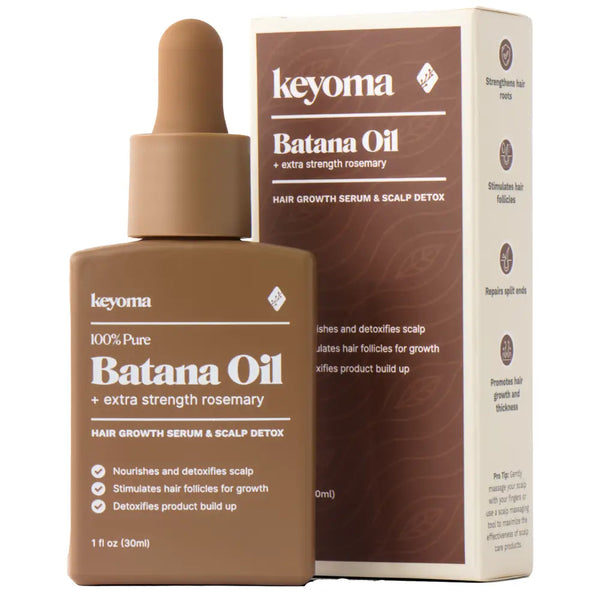
- 30-day supply $50
- 30% off for life $6
- Free haircare essentials kit $33
- Free custom wooden comb $10
- Free scalp massager $15
- Free eco-friendly travel bag $8

